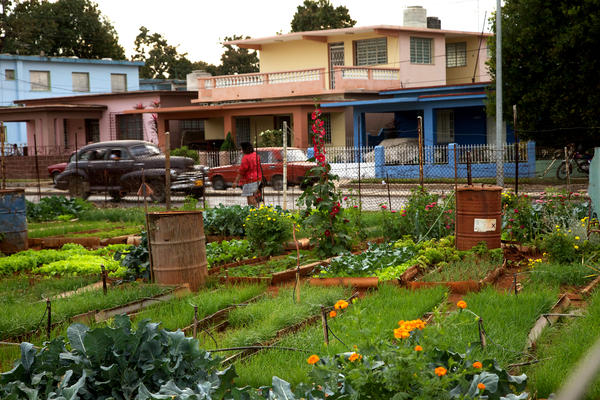

Organic urban farm in Havana, Cuba
U.S. farmland in the Midwest has lost over one-third of the soil necessary to sustain crop production, according to scientists at University of Massachusetts, Amherst. The study concluded that fertile soil has been destroyed — not as a result of natural wind and water erosion, but by a century of overplowing. (tinyurl.com/wps8c99c)
Topsoil is the “black, organic, [carbon and mineral] rich soil that’s really good for growing crops,” said Evan Thaler, Ph.D. student at UMass. Topsoil accumulates over centuries and is teeming with microorganisms.
The healthy and fertile soil was effectively managed and stewarded by Indigenous peoples of the region for centuries, if not millennia. But after a few hundred years of hyperexploitation, first by European colonial settlers and later big agribusiness, a third of all the topsoil across Illinois, Iowa, Indiana and Minnesota is now gone according to a study reported in the Proceedings of the National Academy of Sciences. (tinyurl.com/3yxy4v9d) This figure is much higher than has been reported by the U.S. Department of Agriculture. Lead researcher Thaler said, “I think the USDA is dramatically underestimating the amount of loss.” (NPR)
This assessment is corroborated by a 2006 study from Cornell University which found fertile soil is disappearing faster than it’s being replaced, stating: “Each year about 10 million hectares of cropland are lost due to soil erosion, thus reducing the cropland available for food production. The loss of cropland is a serious problem because the World Health Organization reports that more than 3.7 billion people are malnourished in the world. Overall soil is being lost from land areas 10 to 40 times faster than the rate of soil renewal imperiling future human food security and environmental quality.” (tinyurl.com/cpav2xj9) [One hectare is the equivalent of 100 acres.]
This follows a global trend that has caused a drastic reduction in fertile farmland due to capitalist overdevelopment. Almost all food production — 99.7%, according to the Cornell study — depends on healthy topsoil. But half of it has been destroyed in the last 150 years according to the World Wildlife Federation. (tinyurl.com/pxkcx37b)
An impending food crisis is not the only issue at stake. Low-nutrient soil produces low-nutrient crops. Food today simply does not have as many vitamins and minerals as it did a few decades ago.
Another study, conducted by the University of Texas at Austin, found “‘reliable declines’ in the amount of protein, calcium, phosphorus, iron, riboflavin (vitamin B2) and vitamin C” in dozens of fruits and vegetables since 1950. (tinyurl.com/3nhwhzza)
Corporate genetic modification of plant species, like corn, is aimed at making more profitable — not healthier — produce. “Efforts to breed new varieties of crops that provide greater yield, pest resistance and climate adaptability have allowed crops to grow bigger and more rapidly, but their ability to manufacture or uptake nutrients has not kept pace with their rapid growth,” the UT study claimed.
Cuba shows the way
There is a model, however, for soil replenishment and food production that could point to a way forward that would avoid famine and nutritional starvation. And it comes, unsurprisingly, from the socialist world.
The “Special Period” in the history of revolutionary Cuba refers to the great upheaval immediately after the dissolution of the Soviet Union, which socialist states around the world had depended on.
In 1993, the Cuban Communist Party formed agricultural cooperatives to manage hundreds of state-owned farms. The goal was to increase domestic food production, while providing jobs and housing to Cuban workers, and to rely less on imported chemical pesticides and other synthetic farming techniques.
“The land redistribution program has been supported by solid research-extension systems that have played key roles in the expansion of organic and urban agriculture, and the massive artisanal production and deployment of biological inputs for soil and pest management,” writes Miguel Altieri, one of the founders of the Cuban Association of Organic Agriculture. (Monthly Review, “The Paradox of Cuban Agriculture,” Jan. 1, 2012)
Even more impressive is the growth of food production on urban farms, or organopónicos. “Cuba’s achievements in urban agriculture are truly remarkable — there are 383,000 urban farms, covering 50,000 hectares of otherwise unused land and producing more than 1.5 million tons of vegetables . . . using no synthetic chemicals. . . . Urban farms supply 70% or more of all the fresh vegetables consumed in cities such as Havana and Villa Clara.”
Capitalism is at a dead-end by every conceivable metric. Socialist societies point the way forward to providing healthy, nutritious foods for all without a profit motive.
Portland, Oregon Fifteen groups endorsed the rally and march in Portland, Oregon, on March 30,…
Hundreds of people — including the marching band BABAM (the Boston Area Brigade of Activist…
Hamdan Ballal, a Palestinian director of the film “No Other Land,” winner of the Oscar…
By Joshua Shurley and Gerry Condon The following article first appeared in Veterans For Peace,…
Secretary of State Marco Rubio began a diplomatic journey to the Caribbean on March 25…
Workers World calls on all students who have citizen rights in the United States and…